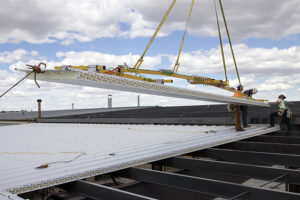Challenges of Handling Insulated Metal Panels (IMP ‘s)
Lifting, moving, and installing insulated metal panels (IMPs) on the job site can be tough. Before vacuum lifting became common, the weight and size of an IMP demanded more time, muscle, and equipment. Other methods also posed greater risks of personal injury and load damage. Suction cup lifters for insulated metal panels have become the preferred method for panel installation and handling.
Flipping Roof Panels

Roofing IMPs typically arrive inverted for cost savings. To prepare a panel for rooftop lifting, it must be flipped face up. Given that these panels can weigh up to 227 kg (500 lb), this task usually requires four people. A vacuum lifter can reduce the number of workers needed by tilting the panel to rest temporarily on its edge before laying it face up on a stack, freeing up crew members for other tasks and minimizing injury risks.
Installing IMP Roof Panels

Using vacuum lifters to install standing-seam or high-rib roof panels offers numerous benefits:
- Reduced Labor: Fewer workers are needed as the lifter adjusts the pitch for installation.
- Ease of Use: The tilt function locks a panel into place without adjusting the pitch, eliminating the need for slings.
- Less Stress: Extensions on vacuum lifters can reduce panel overhang and stress, especially for longer panels.
Installing IMP Wall Panels

Without a vacuum lifter, wall panels are usually installed with clamps, which require drilling holes into the panels. This can lead to delamination or visible damage. Vacuum lifters, on the other hand, attach without modifying the panels:
- Vertical Panels: Vacuum pads attach above the center for stability.
- Horizontal Panels: Pads are placed at or slightly above the center.
IMP Variables
Selecting the right vacuum lifter depends on various factors:
- Panel Characteristics: Consider weight, length, profile, surface texture, metal skins, core material, thickness, and overhang.
- Overhang: Determine allowable overhang based on core material, thickness, and handling angle.
- Vacuum Pads: Choose pads based on panel profile and weight. Softer, taller sealing edges are needed for pronounced features.
- Surface Texture: Mild textures are easier to handle, but rough textures require testing to avoid damage and ensure secure attachment.
Handling Complex Profiles
For aggressive profiles or sensitive surfaces, handling panels from the backside can be beneficial. This method involves positioning the lifter between the panel and the building, anchoring the bottom first, and manually maintaining the upper position before final installation.
Indirect Loading
Dynamic and external forces can affect a vacuum lifter’s load capacity. Account for:
- Weight Amplification: Caused by abrupt movements or changes in direction.
- External Forces: Such as wind gusts affecting the load.
Safety and Efficiency
Vacuum lifters enhance safety, reduce labor, and speed up installations. They should only be used by experienced installers who follow the equipment instructions. Control lines are still necessary, but high-quality lifters offer built-in safety features.
Consult the IMP Experts
Consult with a lifter manufacturer to find the most suitable vacuum lifter for your IMP application. Avoid using vacuum lifters for single sheets or skins, as they can buckle or distort.
Learn more about best practices for IMP installation from the IMP Alliance at MetalConstruction.org.